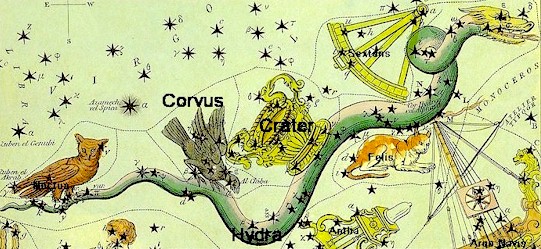Constellations of Words
Explore the etymology and symbolism of the constellations
the Water Snake
Urania’s Mirror1825
Contents:
1. Clues to the meaning of this celestial feature
2. The fixed stars in this constellation
3. History_of_the_constellation
Clues to the meaning of this celestial feature
The Hydra of Lerna was a fabulous water serpent with nine heads, killed by Hercules in the second of his twelve labors. Hercules found that if he cut off one of the heads, two new heads grew back: hence some evils are spoken of as “many headed hydras”. Hercules’ nephew and charioteer, Iolaus, used a burning firebrand to scorch the neck stumps after each decapitation, and Hercules buried the ninth head, the one that was immortal, under a huge stone. The expression “hydra-headed” refers to a weed or trouble that is very difficult to get rid of.
Read the myth of the Hydra of Lernahttp://www.theoi.com/Ther/DrakonHydra.html
Carlos Parada’s webpage on Lernahttp://homepage.mac.com/cparada/GML/Lerna.html
Lerna features in another myth, the myth of the fifty Danaids. The Danaids, except one, killed their bridegrooms on their wedding night, burying their (49) heads in Lerna. There is a common element of beheading and heads in both myths in Lerna. “Now, some may think that the many heads of the Lernaean Hydra—a monster that appeared afterwards—could be the reincarnated heads of the murdered bridegrooms, a curse from the past” [Carlos Parada, Lerna].
This constellation represents the feminine Hydra, the masculine Hydrus is another constellation near the South Pole at the southern end of the river Eridanus (Hydrus might represent the ocean, Oceanus). The etymology for these two constellations are intertwined. Hydra and Hydrus come from the Indo-European root *wed-¹ ‘Water, wet’. Derivatives: water, wet, wash (a body of water), winter (the ‘wet season’), hydrant, hydro-, hydrous, utricle (a membranous sac contained within the labyrinth of the inner ear – involved in balance; also a small vestigial blind pouch of the prostate gland), dropsy, hydathode (water-excreting), hydatid, (these words from Greek hudor, water), undine (a being having water as its element), undulate (wave), abound, abundant, inundate, redound, redundant (‘overflows’ because there is too much of it), surround, (these words from Latin unda, wave), otter (‘water animal’), nutria (from Latin lutra, otter), Hydrus (from Greek hudros, a water snake), Hydra, hydrilla (diminutive of Latin hydra, a submersed plant; Hydrilla verticillata), hydrate (from Greek hudor, a water serpent), hydrocortisone (a steroid hormone to treat inflammatory conditions and adrenal failure), hydrogen (the lightest of all gases and the most abundant element in the universe), hydrochloricacid (HCl, used in petroleum production, it is found in the stomach in dilute form), hydrocephalus (abnormal accumulation of fluid in the cerebral ventricles), hydrops (old-fashioned name for heart failure, caused by a surfeit of water), hydrology, usquebaugh, whiskey, vodka. [Pokorny 9. aw(e)- 78. Watkins
In mythology the Lernaean Hydra was reared by Hera under a plane-tree near the source of the River Amymone, from where she would go out onto the flat-land to raid flocks and ruin the land. A number of sources relate this to flooding water.
Lerna, the scene of the story of the Hydra, was a region of springs, and what is now a former lake, the Alcyonian Lake. The name of this lake, Alcyonia, is cognate with Halcyon, the kingfisher, a fabled bird, that was supposed to have had the power to calm the wind and the waves (Latin unda, wave) on the surface of the sea in order to brood her eggs on a floating nest during the winter solstice. Ceyx and (H)Alcyone were turned into kingfishers. This metamorphosis is the origin of the term “halcyon days“.
The Latin word for otter (from *wed-¹ ‘Water, wet’) is the feminine Latin word lutra, a beast that lives in the water. “The Greek word translated as ‘ichneumon‘ was the name used for the ‘pharaoh’s rat’ or mongoose, which attacks snakes; it can also mean ‘otter‘” []. “The Ichneumon lives in the water, and is thought to be a type of Otter (or the Otter is a type of Ichneumon)” []. The North African mongoose, the ichneumon, is a derivative of ikhnos ‘track, footstep, from this root we get ichnite, a fossilized footprint, ichnography (the art or process of drawing ground plans), ichnology (the branch of paleontology dealing with the study of fossilized footprints, tracks, burrows, or other traces as evidence of the activities of the organisms that produced them).
This constellation represents the Hydra of Lerna. The name Lerna resembles the word learn. An ichnite is a fossilized footprint, the imprint of the sole of the foot. The myth says “even smelling the Hydra’s footprints was enough to bring death to an ordinary mortal”. It was while battling the Hydra that Hercules crushed the Crab (Cancer) under the sole of his foot. The essence of the verb ‘to learn‘ comes from the idea of following tracks, “to follow a course of study”, “gain experience by following a track”. The word learn comes from the Indo-European root *leis-¹ ‘Track, furrow’. Derivatives: last³ (a block or form shaped like a human foot and used in making or repairing shoes. To mold or shape on a last, last, sole of the foot), last² (to continue in time), lore¹, learning, learn (to follow a course of study’), delirium (mental confusion, a going off the ploughed track, a madness, from Latin lira, a furrow). [Pokorny leis– 671. Watkins
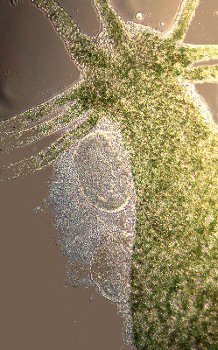
Hydras, Jan Parmentier
Hydra is the name used for the small freshwater polyps of the genus Hydra, having a naked cylindrical body and an oral opening surrounded by tentacles. They are usually a few millimetres long and are best studied with a microscope. Biologists are especially interested in hydras due to their regenerative ability. If a hydra is cut in pieces each piece will turn into a perfect hydra. It was uncertain whether the hydra was a plant or an animal. It was as green as a plant, yet it could move like an animal. A hydra can regrow like a plant propagated from cuttings or from seeds.
[This feminine Hydra and the masculine Hydrus are separate constellations. The etymology for these two constellations are intertwined, the word hydrogen could relate to either or both.] Hydrogen is the most abundant element in the universe. Most of the Earth’s hydrogen is in the form of chemical compounds such as hydrocarbons and water. Hydrogen gas is produced by some bacteria and algae and is a natural component of flatus or flatulence. The myth says “even smelling the Hydra’s footprints was enough to bring death to an ordinary mortal”.
Another version of a legend involving the Hydra is told in Ovid’s Fasti [2.243-66], that the adjacent Raven (Corvus), being sent with a cup (Crater) for water, loitered at a fig-tree until the fruit became ripe, and then returned to the Sun-god, Apollo, with a water-snake (Hydra) in his claws, told Apollo the lie that the snake was the cause of his delay. In punishment he was forever fixed in the sky with the Cup (Crater) and the Snake (Hydra) []. The Hydra caused the snake’s delay (even if it was not the complete truth).
Biologists believe that all life began with a common ancestor (from *ked). Hydra is the name for any of several small freshwater polyps of the genus hydra. In 1740, Abraham Trembley, with the aid of a microscope, discovered the green species of hydra, Chlorohydra viridissima. Here was a creature, the hydra, that seemed to have characteristics of both plants and animals, that seemed to be on the border between the plant and animal kingdoms. With this discovery the concept of a great chain of being was developed long before the idea of evolution became widely accepted. Perhaps the Hydra, which can reproduce both sexually and asexually, is the common ancestor of all life on earth.
The alpha star of this constellation, Alfard, is also called ‘the Solitary‘, or the ‘Solitary One in the Serpent’. In mythology the Hydra had an uncertain number of heads, of which the middle one was immortal which Hercules cut off and placed under a rock. The alpha star, Alfard, might represent this head (and maybe the Sun, Sol, that the planets revolve around?). A part of this constellation was the Chinese Moon Mansion Lieu, was an emblem of immortality. It has often been assumed that hydras are unique among animals in that they do not undergo senescence (aging), and so are biologically immortal []. However, having sex kills them.
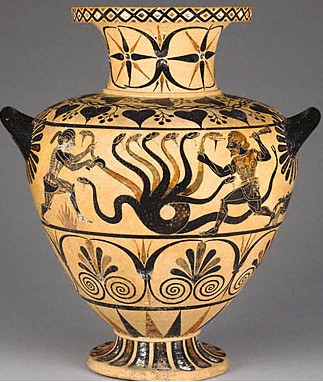
Hercules slaying the Lernean hydra. Caeretan Hydria, Circa 6th BC, Malibu, The J. Paul Getty Museum, Malibu, California
‘Herakles and the Hydra’; the Greek hero Herakles battles the Lernean Hydra while a large crab nips at his foot. His companion Iolaos attacks from the other side, cutting off one of the monster’s heads. The ichneumon was the name used for the mongoose, can also mean ‘otter‘. Mongoose from Dravadian mangus, Mungos mungo, resembles the word mung in mung beans? See picture, the heads of the Hydra look like sprouting mung beans. [Just a suggestion.]
“They talk also of Hydra, a serpent with nine heads, which in Latin is called ‘water-snake’ (excetra), because when one head was cut off three would grow back. But in fact Hydra was a place that gushed out water, devastating a nearby city; if one opening in it were closed, many more would burst out. Seeing this, Hercules dried up the area, and thus closed the opening for the water. Indeed hydra means ‘water’ (compare Greek hudor). Ambrose makes mention of this in a comparison of it with heresies, saying (OnFaith 1.4): “For heresy, like a certain hydra in the fables, grew from its own wounds, and as often as it would be cut down, it spread; it should be fed to the fire and will perish in a conflagration” [p.246.] “The hydra (hydra) is a dragon with many heads; this kind of dragon was in the Lernean swamp in the province of Arcadia. It is called excetra in Latin, because when one head is ‘cut off, three (caesustria) more grow back. But this is only a story; for it happens that Hydra was a place that spewed out floods that devastated the neighboring city. If one outlet for the water were closed up in this Hydra, many others would burst forth. When Hercules saw this he dried up the place itself and thus closed up the path of the floods” [p.256.] [The Etymologies of Isidore of Seville, 7th century AD] A hydria is a three-handled water pitcher.
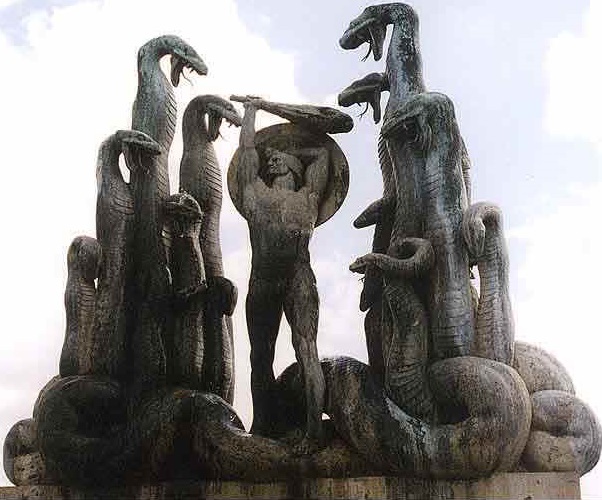
A depiction by Rudolph Tegnar (1873-1950) show Hercules battling the Hydra.Above we said the ‘ichneumon‘ was the name used for the ‘pharaoh’s rat’ or mongoose, which attacks snakes and its name is related to hydr-.
Another mongoose is the Meerkat, or suricate, a small carnivores animal in the mongoose family (Herpestidae). These animals often pop up out of their burrows all at once and stand on their hind legs together, reminding me of Rudolph Tegnar’s depiction of the hydra heads.
© Anne Wright 2008.
| Fixed stars in Hydra | |||||||
| Star | 1900 | 2000 | R A | Decl 1950 | Lat | Mag | Sp |
| delta | 08LEO55 | 10LEO18 | 128 45 09 | +05 52 45 | -12 23 49 | 4.18 | A0 |
| sigma | 09LEO50 | 11LEO13 | 129 02 11 | +03 31 05 | -14 36 22 | 4.54 | K3 |
| eta | 10LEO55 | 12LEO18 | 130 09 11 | +03 34 46 | -14 15 18 | 4.32 | B5 |
| epsilon | 10LEO58 | 12LEO21 | 131 01 57 | +06 36 12 | -11 06 26 | 3.48 | G0 |
| rho | 11LEO32 | 12LEO55 | 131 26 47 | +06 01 25 | -11 33 21 | 4.42 | A0 |
| zeta | 13LEO12 | 14LEO35 | 133 11 17 | +06 08 13 | -10 58 25 | 3.30 | G5 |
| theta | 18LEO54 | 20LEO17 | 137 56 27 | +02 31 35 | -13 03 08 | 3.84 | A1 |
| Alfard alpha | 25LEO53 | 27LEO17 | 141 16 57 | -08 26 27 | -22 23 09 | 2.16 | K3 |
| iota | 26LEO16 | 27LEO39 | 144 19 33 | -00 54 54 | -14 16 47 | 4.10 | K3 |
| upsilon | 04VIR19 | 05VIR42 | 147 16 05 | -14 36 40 | -26 04 45 | 4.29 | G6 |
| lambda | 07VIR59 | 09VIR22 | 152 02 15 | -12 06 22 | -22 00 48 | 3.83 | G9 |
| mu | 13VIR40 | 15VIR03 | 155 55 03 | -16 34 50 | -24 40 16 | 4.06 | K5 |
| nu | 18VIR59 | 20VIR22 | 161 47 21 | -15 55 53 | -21 48 05 | 3.32 | K3 |
| xi | 06LIB37 | 08LIB00 | 172 38 04 | -31 34 51 | -31 35 43 | 3.72 | G7 |
| beta | 12LIB04 | 13LIB27 | 177 35 39 | -33 37 47 | -31 28 01 | 4.40 | B9 |
| gamma (46) | 25LIB38 | 27LIB01 | 199 02 58 | -22 54 30 | -13 44 21 | 3.33 | G6 |
| 49 | 07SCO15 | 08SCO38 | 210 52 46 | -26 26 33 | -13 02 37 | 3.48 | K3 |
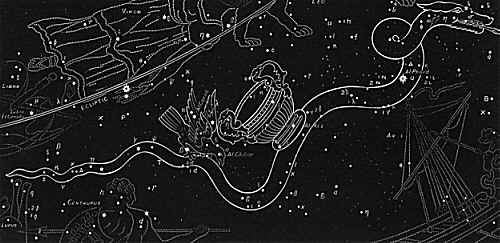
The threefold constellationsHydraCorvusandCraterThe Witness of the Stars].
History of the constellation
from Star Names,1889, Richard H. Allen
Close by the Serpent spreads; whose winding Spires
With ordered stars resemble scaly Fires.
— Creech’s Manilius
The Hydra of Lerna with its multiple heads represents the Water-snake which Hercules encountered and combated in his second labor, is the French Hydre, the German GrosseWasserschlange, and the Italian Idra, and may be classed among the Argonautic constellations, as it was said to represent the DragonofAetes
{Page 247} Its stars are now well defined under this single title, but anciently were described, with their riders Corvus and Crater, as Ovid wrote:
Anguis, Avis, Crater, sidera juncta micant
This continued to the 18th century, Flamsteed and other early astronomers making of them even four divisions, Hydra, HydraetCrater, HydraetCorvus, and ContinuatioHydrae. Nepa and Nepas, originally African words for the terrestrial crab (Cancer) and scorpion (Scorpius), seem also to have been used for this constellation in classic times.
In Low Latin it has been Hidra, Idra, and Ydra; and, in the Almagest of 1551, Hydrus in the masculine, which, correct enough before Bayer’s day, would now confound it with the new southern figure (Hydrus). Riccioli, and Hyde in his translation of Ulug Beg’s catalogue, had it thus, showing its continuance till then as a common title, although often written Idrus and Idrusaquaticus, as well as changed to Serpensaquaticus
Other names, also used for the northern Dragon (Draco), have been Draco, Asiua, and Asuia, or Asvia. Chilmead wrote it Alsugahh. Still another conception and title may be seen in the AraboLatinAlmagestStellatioYdre: etestspeciesserpentium; etjamnominaturAsiua
Coluber, the Snake, and Echidna, the Viper, also obtain for Hydra, with the adjectives Furiosus, Magnanimus, and Sublimatus, here used as proper nouns, as they were for Orion. The Arabians similarly called it AlHayyah, another of their words for a snake, — ElHavic in Riccioli’s NewAlmagest
Its representation has generally been as we have it, but the Hyginus of 1488 added a tree in whose branches the Hydra’s head is resting; probably a recollection of the dragon that guarded the apple-trees of the Hesperides, although this duty really belonged to our Draco; and at times it has been shown as three-headed. Map-makers have always figured it in its present form, the Cup resting midway on its back, with the Raven pecking {Page 248} at one of its folds; Hydra preventing the latter’s access to the Cup in punishment for its tattling about Coronis; or for its delay in Apollo’s service. The minor constellation Turdus, or Noctua, only recently has been added to it.
Those who saw biblical symbols among the stars called Hydra the Flood; Corvus, Noah’sRaven; and Crater, the Cup “out of which the patriarch sinned”; but Julius Schiller said that the whole represented the RiverJordan
The 7th sieu, Lieu, a Willow Branch, or Liu, a Circular Garland, — was the creature’s head, 15° south of Praesaepe, delta being the determinant, and formed the beak of the Red Bird; it governed the planets and was worshiped at festivals of the summer solstice as an emblem of immortality.
Here, too, was the 7th nakshatra, Aclesha, or Acresha (Ashlesha ninth nakshatra or Moon Mansion), the Embracer, figured as a Wheel, with Sarpas, the Serpents, as presiding divinities; epsilon marking the junction with the nakshatra Magha.
The 8th sieu (Chinese Moon Mansion), Sing, a Star, anciently Tah, was formed by alpha, delta, and tau, with others smaller lying near them, alpha (Alfard) being the determinant. This asterism constituted the neck of the Red Bird, and, Edkins asserts, was also known as the SevenStars
The 9th sieu (Chinese Moon Mansion) consisted of kappa, nu, nu, lambda, mu, phi, and another unascertained, and was called Chang or Tchang, a Drawn Bow, — Brown says “anciently Tjung, the Archer,” — nu being the determinant; the god Chang using this bow to slay the Sky Dog, our Crater. The stars between Corvus and Crater were KienMun, and those between gamma Hydrae and Spica of the Virgin (Virgo) were TienMun, Heaven’s Gate. These lie beyond the outlines of the Virgin’s robe on the Heis map, but on Burritt’s are included in the tip of her left wing.
Hydra is supposed to be the snake shown on a uranographic stone from the Euphrates, of 1200 B.C., “identified with the source of the fountains of the great deep,” and one of the several sky symbols of the great dragon Tiamat. Certain stars near, or perhaps in the tip of Hydra’s tail and in Libra, seem to have been the Akkadian En-te-na-mas-luv, or En-te-na-mas-mur, the Assyrian Etsen-tsiri, the Tail-tip.
Theon said that the Egyptians considered it the sky representative of the Nile, and gave it their name for that river.
After Al Sufi’s day, in our 10th century, the figure was much lengthened, and now stretches for nearly 95° in a winding course from Cancer to Scorpius; this well agreeing with the fable of its immense marine prototype, the Scandinavian Kraken. Conrad Gesner, the 16th-century naturalist, gave an illustration of this in its apparently successful attack upon the ship Argo.
{Page 249} The constellation cannot be seen in its entirety till Crater is on the meridian. Argelander enumerates in it 75 stars; Heis, 153.
For an unknown period its winding course symbolized that of the moon; hence the latter’s nodes are called the Dragon’s Head and Tail. When a comet was in them poison was thought to be scattered by it over the world; but these fanciful ideas are now associated with Draco
Al Sufi mentioned an early Arab figure, AlH’ail, the Horse, formed from stars some of which now belong to our Hydra, but more to Leo and Sextans.
Star Names: Their Lore and Meaning, Richard H. Allen, 1889.]
